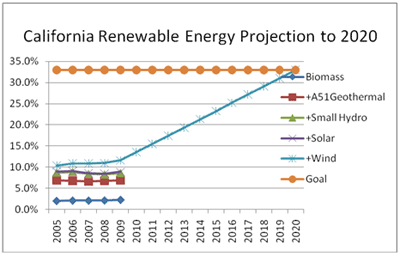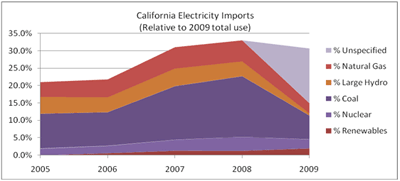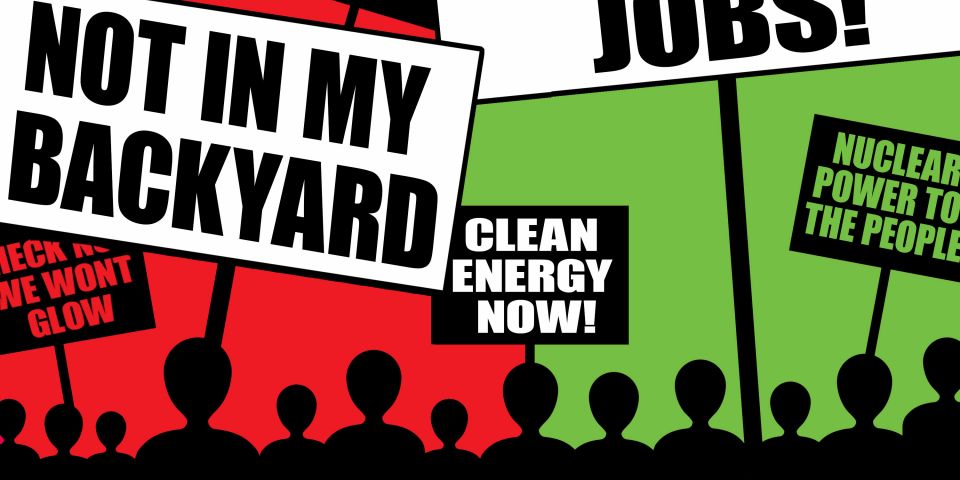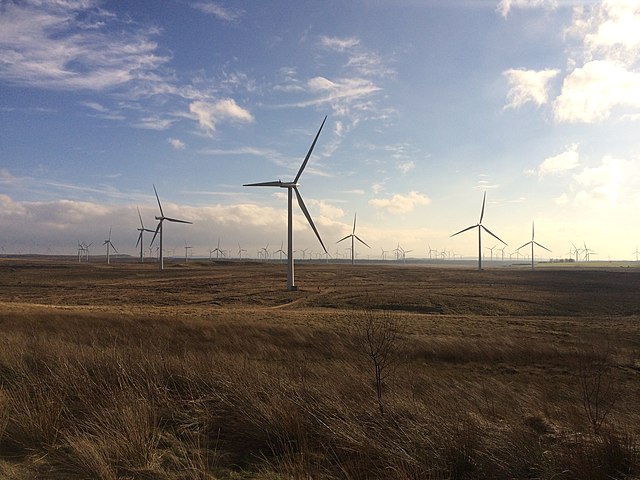Can California meet its Renewable Energy Portfolio?
California has recently adopted a renewable energy portfolio with the goal to provide 33 percent of its electricity from renewable resources such as wind, solar, geothermal, biomass, and small hydroelectric facilities by 2020.
Can this portfolio succeed? It is an ambitious goal, but it takes more than legislative action for such a program to go forward. It takes an actual plan that can be met with actual engineering accomplishments.
In order to determine the probability of success, we can look at California's renewable energy sources in prior years. These are available on the Internet and are presented in the following graph.
The plot shows the actual renewable sources of electricity generated in California from 2005 to 2009 and shows the projected increase required to achieve the goal of 33 percent by 2020. Notice that the renewable contribution has been rather constant over the previous years and requires a dramatic increase to achieve the goal. This implies that something different needs to be done than what has been done it the past, otherwise the projection line will be ever steeper and eventually needs to be abandoned.
So, exactly which of the renewable energy sources can be increased to reach the goal? It is generally accepted that biomass, geothermal, and small hydro cannot be increased significantly, which leaves the intermittent sources of solar and wind to do the job. Is it reasonable to expect that solar and wind can accomplish the task? The gap that must be closed by 2020 is 21 percent of the total electricity consumption.
Solar currently contributes only 0.3 percent (2009) of the electricity used in California. This contribution is too small to expect a significant contribution by 2020. It might be doubled by 2020, but this is still a small amount.
The wind contribution is 2.7 percent (2009), which is a bit larger. The expectation that it will close the 21-percent renewable gap is unrealistic, however, for the following reasons:
- Meeting the goal would require adding about 2-percent wind generation every year for 10 years. This yearly increase is about equal to the total wind generation in California today. It is unreasonable that many wind turbines (tens of thousands) could be built and installed somewhere in California every year.
- Another reason is that the California grid (or any grid) cannot handle 20-percent generation from wind energy. It is generally accepted that 20-percent wind capacity is the limit that an isolated grid can handle. (Capacity is quite different from generation for wind turbines. For each unit of capacity addition, there is only ¼ of a unit for generation addition because of wind intermittency).
So. if California is able to add the maximum amount of capacity (20 percent), it would only translate to generation of about 5 percent. California, therefore, already has about half the wind energy that the grid could ever handle. With a crash program to build all the wind turbines that California could handle, the total renewable contribution might increase to 15 percent by 2020 (11.6 percent current contribution, which includes 2.7 percent wind plus 2.3 percent maximum potential wind increase). This is still a long way from 33 percent.
So, the question still is how California expects to reach its 33 percent renewable goal. To shed some light on that question, we must examine California electricity imports.
California electricity imports
California does not generate all the electricity used in the state. The plot below shows the historical imports into California.
The plot shows that in some years, the electricity imports have exceeded 30 percent. The large increase in 2006-2007 has come as a result of the virtual elimination of in-state electricity generation using coal. This reduction in in-state generation needed to be compensated by an increase in imports (largely from imported coal generation). So far, the net effect of California's desire to go green is to shift the coal generation to other states.
The reduction of in-state coal generation is shown in the next plot, which shows all the in-state generation. (Both of these plots are normalized to the total 2009 energy consumption because of my desire to use the units of % and, at the same time, show real generation trends that are not confused by changes in electricity demand.)
One of the interesting aspects of the imports graph is the "unspecified" portion of the imports in 2009, which is thusly explained:
Due to legislative changes required by Assembly Bill 162 (2009), the California Air Resources Board is currently undertaking the task of identifying the fuel sources associated with all imported power entering into California.
This unspecified portion of the imports is about 15 percent of the total generation.
If we compare the 2009 imports to the 2008 imports, it is clear that much of this "unspecified" portion actually comes from imported coal generation, with a smaller amount from hydro and natural gas.
If California can reclassify this "unspecified" portion of its energy mix as "renewable," then a good portion of the renewable portfolio could be met. That appears to be the plan, as will be explained further in tomorrow's post.
Imported wind generation
There has been a substantial increase in the use of wind-generated electricity in California, as shown in the plot below. Most of the increase since 2005 has come from imports.
One might think that a few percent of intermittent wind on the grid would not cause problems, but this amount is an average over a whole year. This amount is, in fact, a problem at times during the year when demand for electricity is low and the wind generation is high. At those times, electricity distribution systems find themselves in a no-win situation, where they have to break wind generation contracts in order not to violate existing electricity distribution laws. This has already resulted in lawsuits brought against BPA by the wind industry.
These lawsuits need to be defeated. We can't make laws giving a privilege to one industry, such as a mandated market for wind, which requires other entities to break existing laws. Furthermore, the wind industry should not be compensated for not producing power at those times. It should be a risk of doing business. Such risks are normally accepted by other industries.
The wind generation that is discussed above is generation that is actually used in California. There also exists wind generation that is not used in California, but is credited to the state. This is discussed in Part II of this article, which will appear tomorrow.
____________________________________________________
Ulrich Decher holds a PhD in nuclear engineering. He is a member of the ANS Public Information Committee and a contributor to the ANS Nuclear Cafe.









